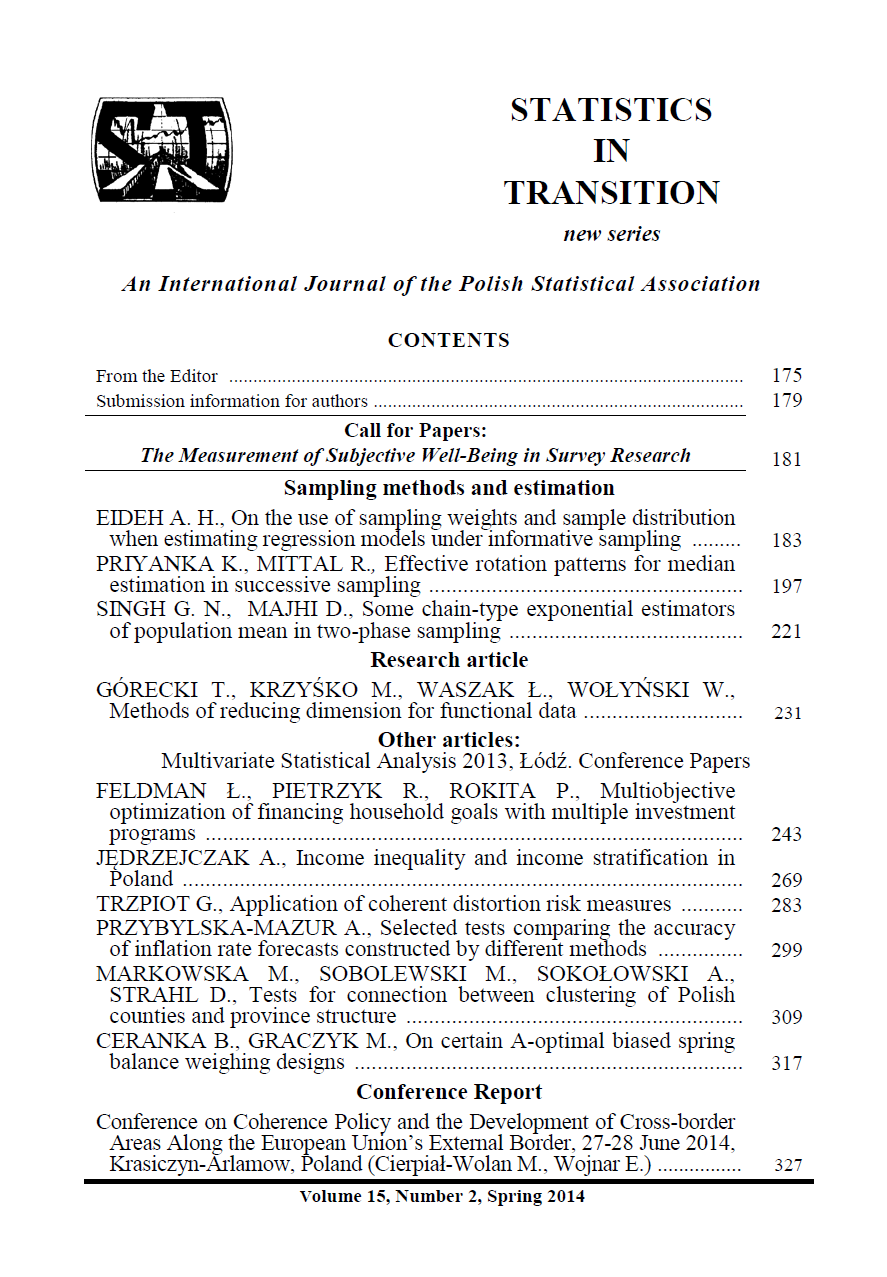ARTICLE
ABSTRACT
Income inequality refers to the degree of income differences among various individuals or segments of a population. When the population has been partitioned into subgroups, according to some criterion, one common application of inequality measures is evaluation of the relationship between inequality in the whole population and inequality in its constituent subgroups in order to work out the within and the between subgroups contributions to the overall inequality. In the paper selected decomposition methods of the well-known Gini concentration ratio were discussed and applied to the analysis of income distribution in Poland. The aim of the analysis was to verify to what extent the inequality in different subpopulations contributes to the overall income inequality in Poland and to what extent their members form distinct segments or strata. To provide the decomposition of the Gini index the population of households was partitioned into several socio-economic groups on the basis of the exclusive or primary source of maintenance. Moreover, the households were divided by economic regions using the Eurostat classification units NUTS 1 as well as by family type defined by the number of children
KEYWORDS
income distribution, income inequality
REFERENCES
BHATTACHARYA, N., MAHALANOBIS B., (1967). Regional disparities in household consumption in India, Journal of the American Statistical Association 62 (317), 143–161.
DAGUM, C., (1980). Inequality Measures Between Income Distributions with Application. Econometrica 48(7), 1791–1803.
DAGUM, C., (1997). A New Approach to the Decomposition of the Gini Income Inequality Ratio, Empirical Economics 22(4), 515–531.
DEUTSCH, I., SILBER J., (1999). Inequality Decomposition by Population Subgroups and the Analysis of Interdistributional Inequality, in: J. Silber, Handbook of Income Inequality Measurement, 363–397.
GASTWIRTH, J. L., (1972). The Estimation of the Lorenz Curve and the Gini Index, Review of Economics and Statistics 54(3), 306–316.
GINI, C., (1912). Variabilita e Mutabilita, Bologna, Tipografia di Pado Cuppini.
GINI, C., (1916). Il Concetto di Transvariazione e le sue Primi Applicazioni, Giornale degli Economisti e la Rivista Statistica, [in:] Gini (1959), 21–44.
GINI, C., (1959). Memorie di Metodologia Statistica, vol. II. Libreria Goliardica, Roma.
JĘDRZEJCZAK, A., (2010). Decomposition Analysis of Income Inequality in Poland by Subpopulations and Factor Components, Argumenta Oeconomica 1(24), 109–123.
JĘDRZEJCZAK, A., KUBACKI, J., (2013). Estimation of Income Inequality and the Poverty in Poland by Region and Family Type, Statistics in Transition 14(3), 359-378.
MEHRAN, F., (1975). A Statistical Analysis on Income Inequality Based on Decomposition of the Gini Index. Proceedings of the 40th Session of ISI.
MOOKHERJEE, D., SHORROCKS, A., (1982). A Decomposition Analysis of the Trend in UK Income Inequality, The Economic Journal 92(368), 886–902.
MONTI, M., (2007). Note on the Dagum Decomposition of the Gini Inequality Index, Universita Degli Studi di Milano Working Papers 2007–16.
MORGAN, J., (1962). The Anatomy of Income Distribution, Review of Economics and Statistics 44(3), 270–282.
PYATT, G., (1976). On the Interpretation and Disaggregation of Gini Coefficient, The Economic Journal 86(342), 243–255.
RADAELLI, P., (2010). On the Decomposition by Subgroups of the Gini and Zenga‘s Uniformity and Inequality Indexes, International Statistical Review, 78(1), 81–101.
SHORROCKS, A., (1984). Inequality Decomposition by Population Subgroups, Econometrica 52(6), 1369–1385.
SOLTOW, L., (1960). The Distribution of Income Related to Changes in the Distributions of Education, Age, and Occupation, The Review of Economics and Statistics 42(4), 450–453.
SILBER, J., (1989). Factor Components, Population Subgroups and the Computation of the Gini Index of Inequality, The Review of Economics and Statistics 71(2), 107–115.
VERNIZZI, A., (2009). Applying the Hadamard Product to Decompose Gini, Concentration , Redistribution and Re-ranking Indices, Statistics in Transition 10 (3), 505–524.
YITZHAKI, S., (1994). Economic Distance and Overlapping of Distributions, Journal of Econometrics 61(1), 147–159.
YITZHAKI, S., LERMAN, R., (1984). A Note on the Calculation and Interpretation of the Gini Index, Economic Letters 15(3-4), 363–369.
YITZHAKI, S., LERMAN, R., (1991). Income Stratification and Income Inequality, Review of Income and Wealth 37(3), 313–329
